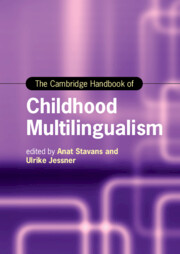Book contents
- The Cambridge Handbook of Childhood Multilingualism
- Cambridge Handbooks in Language and Linguistics
- The Cambridge Handbook of Childhood Multilingualism
- Copyright page
- Contents
- Figures
- Tables
- About the Editors
- Contributors
- Acknowledgments
- Multilingualism Is Not Bilingualism +1: An Introduction
- Part One Becoming and Being a Multilingual Child
- Part Two Cognition and Faculties in Multilinguals
- Part Three Family Language Policy
- Part Four Language(s) and Literacy of Multilingual Children through Schooling
- Part Five Socialization in Childhood Multilingualism
- Part Six Multilingual Children’s Landscape
- 26 Linguistic Landscapes in the Home: Multilingual Children’s Toys, Books and Games
- 27 Linguistic Landscapes in School
- 28 Children’s Perception of Multilingual Landscapes in Interaction
- Subject Index
- Country Index
- Language Index
- References
27 - Linguistic Landscapes in School
from Part Six - Multilingual Children’s Landscape
Published online by Cambridge University Press: 18 August 2022
- The Cambridge Handbook of Childhood Multilingualism
- Cambridge Handbooks in Language and Linguistics
- The Cambridge Handbook of Childhood Multilingualism
- Copyright page
- Contents
- Figures
- Tables
- About the Editors
- Contributors
- Acknowledgments
- Multilingualism Is Not Bilingualism +1: An Introduction
- Part One Becoming and Being a Multilingual Child
- Part Two Cognition and Faculties in Multilinguals
- Part Three Family Language Policy
- Part Four Language(s) and Literacy of Multilingual Children through Schooling
- Part Five Socialization in Childhood Multilingualism
- Part Six Multilingual Children’s Landscape
- 26 Linguistic Landscapes in the Home: Multilingual Children’s Toys, Books and Games
- 27 Linguistic Landscapes in School
- 28 Children’s Perception of Multilingual Landscapes in Interaction
- Subject Index
- Country Index
- Language Index
- References
Summary
The linguistic landscape (LL) is powerful for young children. They react react to the LL and benefit from (attractive) signs for early literacy or language learning. They create signs and bring their out-of-(pre-)school experiences into the educational space. Finally, they actively engage with the LL and discover the symbolic function of signage and ideologies of language and language use. This chapter on LL in school starts with an overview of the development of linguistic landscape research in general. This is followed by a presentation of studies on landscapes inside and outside schools and on pedagogical and didactic activities that draw on the potentialities of signage. With this, the chapter showcases major results of linguistic landscape research in the field of early schooling and draws on a variety of theoretical and methodological groundings of this research.
- Type
- Chapter
- Information
- The Cambridge Handbook of Childhood Multilingualism , pp. 623 - 648Publisher: Cambridge University PressPrint publication year: 2022



